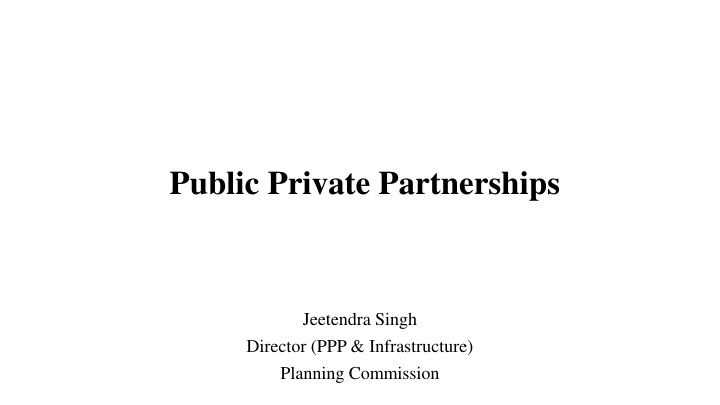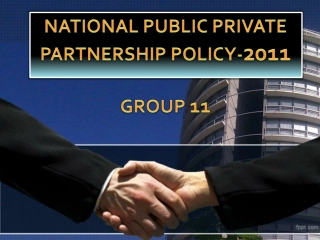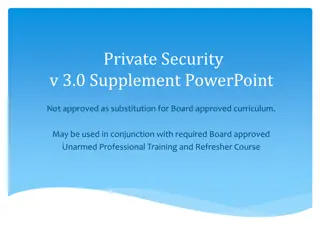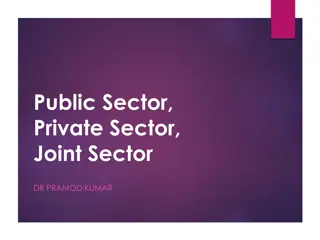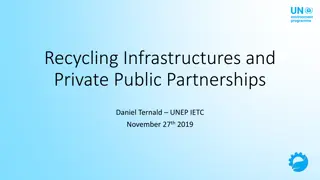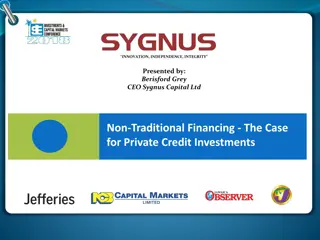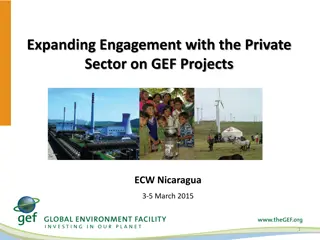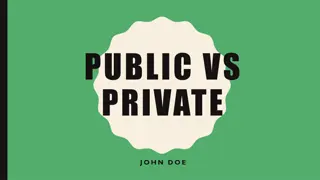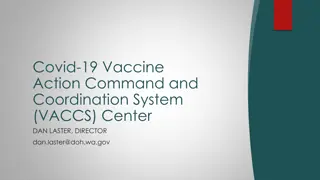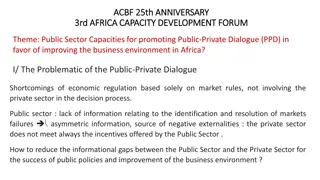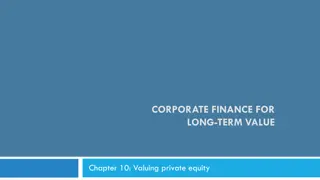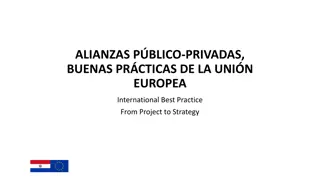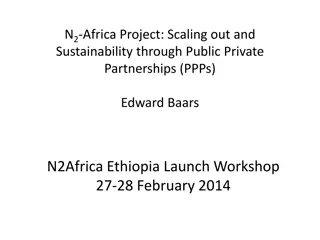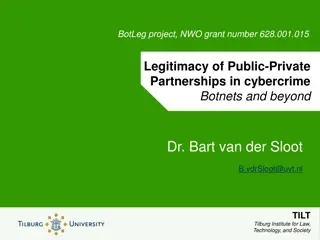Public Private Partnerships
Authors Gerald D. Toland, Jr., PhD, William E. Nganje, PhD, and Raphael Onyeaghala, PhD, analyze future trends in US agri-food policy, exploring positive and normative influences driving change and discussing strategies for effective policy implementation. The Global Food Security Act of 2016 is highlighted as a promising policy with bipartisan support to address global food security challenges.
Download Presentation

Please find below an Image/Link to download the presentation.
The content on the website is provided AS IS for your information and personal use only. It may not be sold, licensed, or shared on other websites without obtaining consent from the author.If you encounter any issues during the download, it is possible that the publisher has removed the file from their server.
You are allowed to download the files provided on this website for personal or commercial use, subject to the condition that they are used lawfully. All files are the property of their respective owners.
The content on the website is provided AS IS for your information and personal use only. It may not be sold, licensed, or shared on other websites without obtaining consent from the author.
E N D
Presentation Transcript
Public Private Partnerships Jeetendra Singh Director (PPP & Infrastructure) Planning Commission
What we are going to cover in this session? What we are going to cover in this session? Issues with infrastructure, a natural monopoly; how governments across the world have handled these issues in the past; regulatory regimes What is PPP ? Why PPP ? How PPP? Lifecycle of a PPP project Transaction process in PPP project Award - RFQ, RFP & Concession Award Bankability of infrastructure concessions; credit enhancement measures Design of Concession Agreement international best practices International experiences in PPP Cross sectoral examples - power generation & transmission, water & sanitation, highway, rail and airport sectors
Monopolies & Infrastructure Monopolies & market power Governments concerned about Monopolies Infrastructure A Natural Monopoly Economies of scale Durable & immobile investments High entry barriers No close substitutes Public vs Private provision of infrastructure - changing trends in 19th, 20th & 21st century across countries and sectors Establishing a credible commitment is an issue
Institutional mechanisms/instruments to handle monopolies Concession contracts Public Sector/ Government Private contracts Discretionary Regulation Cost of Service Price Cap Competitive Negotiated Role of markets in determining prices and quantities Adapted from Regulating Infrastructure, Jose A. Gomez Ibanez, Harvard Press
Institutional mechanisms/instruments to handle monopolies contd Option Benefits Issues Private Contract Commitment Competition: better services & lower costs Risk of incompleteness High transaction costs Enforcement: fair legal system Risk of incompleteness Trust Concession Contract Commitment Competition: better services & lower costs Enforcement: fair legal system Trust Discretionary Regulation Flexible for future unforeseen changes Risk of capture; special interests
Infrastructure monopolies contd Varied solutions over time Market orientation preferable Issue of commitment vs flexibility Discretionary regulation vs regulation by contract
Solutions Sources of instability to Infrastructure Monopolies Discretionary regulation - Capture Concession contracts Incompleteness Options in case of incomplete contracts Renegotiate Live in unhappy situation bankruptcy/poor service quality
What is PPP? Contractual arrangement between government and private sector company for provision of infrastructure/public service by private sector as per specific performance standards against pre-determined user charges/grant by the government Cross sectoral examples of PPPs: Toll Roads, Water Supply, Power Generation, Power Transmission, Railway Lines, Airports
Characteristics of PPPs Legally enforceable contract Long term, typically 20 to 30 years or even more; why long term? Investment of large resources by private sector User charges for output and not input Risk transfer from govt to private sector; how much risk to retain and how much to transfer? Value for Money (VfM)
PPP a network of contracts Authority Promoters Lenders Raw Material Providers Constructi on Contractor SPV Guarantee Providers O&M Contractor Escrow Bank
Why PPP ? Need for economic growth Meet people s aspirations Need to build infrastructure Limited government budget; fiscal constraints Bring additionality in investment Bring efficiency gains With predetermined user charges, incentives to reduce wastages and minimize costs Penalties for not meeting specified outputs Government benefitted by lower bid price in competitive bidding capturing the efficiency gains
How PPP? A PPP project cycle Bidding Project Concept Feasibility Study Concession Agreement Financial Closure Approval Construction Operation Transfer RFQ&RFP
Bid process & documents are crucial PPPs Large investments Long duration High risks Complexities Sub - optimal bid documents & process puts project at risk Large effort required in beginning Push from the top
PPP Bidding process Project preparation & structuring Consultant selection single stage, 2 envelope process Technical Consultant Legal Adviser Financial Consultant Concessionaire selection 2 stage process Request for Qualification (RFQ) Request for Proposals (RFP) Signing of Concession Agreement (CA)
Consultant selection is critical Poorly structured PPP contract can compromise user interests Technical, financial & legal issues - complexity In house expertise not adequate/time constraints
Consultant procurement Consultant procurement different from goods procurement Combined QCBS based selection procedure Individual experts matter more than firm Separate consultants reqd; technical, financial, legal TOR is important
Consultant procurement process Single stage two envelope bidding process Technical bid Financial bid Technical evaluation Shortlisting Financial evaluation Combined score Selection based on highest Combined score
Consultant Procurement Specify time input of each expert Discourage substitution of experts -Strong penalty 1st substitution - 20% fee reduction 2nd substitution 50% fee reduction team leader not be normally substituted Link Payment to Deliverables Final 10% payment on successful execution of Concession Agreement
Deciding the Bid Parameter Option 1 Tariff based bidding (example power purchase agreement) Specify minimum quality of service Award the Concession to the Bidder proposing the lowest tariff Option 2 Revenue sharing based bidding (example air ports) Specify minimum service and maximum tariff Award the Concession to the Bidder who is ready to share the maximum revenue Option 3 Viability Gap based bidding (eample transmission/water supply) Specify minimum service and maximum tariff Award the Concession to the Bidder asking the lowest grant or offering the largest concession fee
Concession Agreement & Bankability A project structured through a sound concession agreement attracts investors, leads to competition and reduces user charge or subsidy Bankability of infrastructure projects is an issue Non recourse financing of infrastructure projects - off balance sheet Concession Agreement should provide support to debt financing Termination payments Compulsory buyout in case of government default
Debt financing support to PPPs in India Creation of India Infrastructure Finance Corporation Ltd (IIFCL) in 2006 IIFCL borrows against sovereign guarantee and lends 30% to infra projects Creation of Infrastructure Debt Funds (IDFs) in 2011 Asset Liability mismatch of commercial banks lending to infrastructure projects Need for credit enhancement IDFs to raise money through institutional investors, HNIs, insurance and pension funds and refinance commercial bank loans to infrastructure projects after start of commercial operation roll over the debt
Concession Agreement Clauses Concession Agreement Clauses Scope of the Project Grant of Concession Conditions Precedent To be fulfilled by Authority To be fulfilled by Concessionaire Damages for delay Obligations Of Authority Of Concessionaire Representation & Warranties Performance Security Amount Duration Appropriation Release
Concession Agreement Clauses Concession Agreement Clauses Right of Way Construction of the Project Monitoring of Construction Completion Date Entry into Commercial Service (COD) Change of Scope Operation & Maintenance Key Performance Indices Availability Reliability Independent Engineer
Concession Agreement Clauses Concession Agreement Clauses Financial Close Grant Concession Fee User Fee Effect of variation on traffic growth Payment security Default Escrow Letter of Credit Escrow Account Revenue shortfall loan
Concession Agreement Clauses Concession Agreement Clauses Insurance Force Majeure Change in Law Protection of NPV Termination Concessionaire default Authority default Substitution Dispute resolution
PPP Concessions International experience
Research Study The Latin American experience Prof J.Luis Guash, 2004 Period: 1985 - 2000 Number of Concessions Analysed: 1000 Concession Period : 20 to 30 years Concessions Renegotiated - 41.5% Electricity 9.7% Transport 54.7% Water & Sanitation 74.4%
Research findings contd. Prof J.Luis Guash Average time to renegotiation 2.2 years (after award) Renegotiation in direct adjudication contracts 8% Renegotiation in competitively bid concessions 46% Who initiated renegotiations Concessionaire 61% Government 26% Both parties 13%
Research findings contd. Prof J.Luis Guash Issues in renegotiations Issues in renegotiations Tariff adjustments Investment obligations and schedules Extension of Concession Changes in asset base for calculating rate of return Pass through cost components in tariff
Latin America Renegotiation results (Guash) Tariff increase 62 % Tariff decrease 19% Reduction in investment obligations 69% Acceleration in investment obligations 18% Increase in cost pass through in tariff 59% Extension of Concession period 38% Decrease in annual fee to be paid by Concessionaire - 31%
Key drivers of renegotiations (Guash) Opportunistic behaviour of firms aggressive bidding Opportunistic behaviour of governments Poor Concession design ambiguities, inadequacy of contract provisions Political cycles Lack of understanding of key determinants Carelessness Misaligned incentives
Latin American Experience with PPPs World Bank Report, 2004 Private participation improved performance & led to efficiency gains in the range of 1 to 9% 63% people in 17 countries in Latin America & Caribbean believe that private participation has not been beneficial Efficiency gain not transferred in tariff reduction; captured by renegotiation (Argentina: efficiency gain 1 to 6%, tariff reduction 1% only) PPP program delayed due to negative perceptions
Renegotiation - threat to PPP Guash regards renegotiation as a problem, not a solution, as it vitiates bidding environment Undermines competitive award process & public trust; welfare loss Leads to long drawn court cases & disputes; draws attention of Audit and Investigative Agencies Well designed Concession Agreements should provide possible responses
